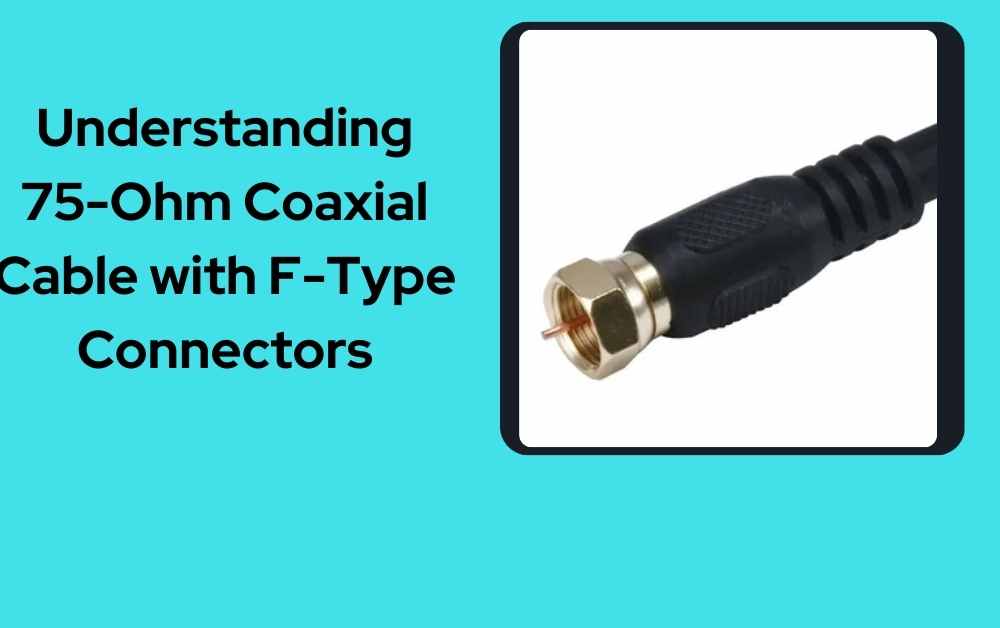Coaxial cables are everywhere in our modern world, connecting our TVs, internet modems, and other devices to deliver audio and video signals. One common type of coaxial cable is the 75 ohm coaxial cable with F-type connectors. In this blog post, we’ll break down the key aspects of this type of cable in simple terms, making it easy for everyone to understand.
What is a Coaxial Cable?
Before diving into the specifics of a 75-ohm coaxial cable with F-type connectors, let’s start with the basics. A coaxial cable, often referred to as coax cable, is a type of electrical cable that consists of a central conductor, an insulating layer, a metallic shield, and an outer insulating layer. This design is essential for transmitting signals effectively while minimizing interference.
The Importance of Impedance: What is 75 Ohms?
Impedance might sound like a complex term, but it’s crucial to understanding coaxial cables. In simple terms, impedance refers to the resistance that a cable offers to the flow of electrical signals. A 75-ohm coaxial cable means that it has a resistance of 75 ohms to the flow of electrical signals.
F-Type Connectors: What Are They?
F-type connectors are a common type of connector used with coaxial cables. These connectors are named after their screw-on design, which resembles the shape of the letter “F.” They are widely used for connecting cable TV, satellite, and other audio/video equipment.
Where You’ll Find 75-Ohm Coaxial Cables with F-Type Connectors:
Now that we understand the basics, let’s explore where you might encounter 75-ohm coaxial cables with F-type connectors in your everyday life:
1. Cable Television (CATV):
- Your cable TV service provider likely uses 75-ohm coaxial cables with F-type connectors to deliver television signals to your home. These cables connect your cable box or TV to the wall outlet.
2. Satellite Television:
- If you have a satellite TV dish at home, the coaxial cables running from the dish to your satellite receiver also typically use F-type connectors.
3. Home Theater Systems:
- Many home theater systems and audio/video equipment utilize F-type connectors for connecting devices like DVD players, Blu-ray players, and AV receivers.
4. Internet Modems and Routers:
- Internet service providers (ISPs) often use 75-ohm coaxial cables with F-type connectors to connect their modems and routers to the cable network.
Advantages of 75-Ohm Coaxial Cables with F-Type Connectors:
Now that we’ve covered where you’ll find these cables let’s explore some of their advantages:
1. Excellent Signal Quality:
- 75-ohm coaxial cables are known for their ability to transmit high-frequency signals with minimal loss, making them ideal for high-definition video and audio applications.
2. Durability:
- F-type connectors are robust and reliable, ensuring a secure and long-lasting connection.
3. Easy Installation:
- The screw-on design of F-type connectors makes them easy to install without the need for special tools.
4. Versatility:
- These cables are versatile and can be used for various applications, including cable TV, satellite, and internet connections.
Considerations When Choosing a 75-Ohm Coaxial Cable:
When selecting a 75-ohm coaxial cable with F-type connectors, there are a few factors to keep in mind:
1. Cable Length:
- Choose the appropriate cable length for your specific installation needs. It’s better to have some extra length than to fall short.
2. Cable Type:
- There are different types of 75-ohm coaxial cables designed for specific applications, such as RG-6 and RG-59. Ensure you choose the one that matches your requirements.
3. Shielding:
- Consider the level of shielding your cable needs to minimize interference. Quad-shielded cables offer better protection against external interference.
4. Connector Compatibility:
- Ensure that the F-type connectors on the cable match the connectors on your devices. Compatibility is crucial for a secure connection.
How to Connect 75-Ohm Coaxial Cables with F-Type Connectors:
Connecting these cables is a straightforward process. Here’s a step-by-step guide:
1. Identify the F-Type Connectors:
- Locate the F-type connectors on both ends of the cable. They look like screw-on cylinders with threads.
2. Align and Screw:
- Align the threads on the male and female connectors and screw them together securely. Hand-tightening is usually sufficient, but you can use a wrench for extra tightness if needed.
3. Secure the Connection:
- Ensure that the connection is snug and secure, without any loose parts. A well-connected cable minimizes signal loss.
4. Test the Connection:
- Once the cable is connected, test the signal on your device to ensure everything is working correctly.
Also read :- Videography Services in Abu Dhabi: Capturing Moments with Excellence
Conclusion:
In conclusion, 75-ohm coaxial cables with F-type connectors are a fundamental part of our modern communication and entertainment systems. They play a crucial role in delivering high-quality audio and video signals to our TVs, internet modems, and other devices. Understanding their basics, advantages, and how to choose and connect them can make your home entertainment and connectivity experiences smoother and more enjoyable. So, the next time you connect your cable TV, satellite dish, or internet modem, you’ll have a better understanding of the technology behind the scenes.



